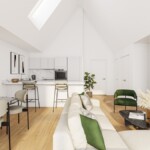Colony Housing Edinburgh, Canonmills Homes Images, Pilrig Property, Scottish Buildings
Edinburgh Colonies Housing
Edinburgh Colonies – Houses, Residential Architecture in Lothian, Scotland
Edinburgh Colonies – in more detail
Shaw Colonies – Pilrig
Rosebank Cottages
Stockbridge Colonies
Dalry Colonies
Shaw Colonies – Pilrig
This model idea for artisan housing in Scotland was pioneered in Edinburgh with a scheme by Patrick Wilson for the Pilrig Model Dwelling Company. This was the first Colony-type development in Edinburgh, known as The Pilrig Model Buildings. They consist of forty- four dwellings, the first sixteen completed in 1850, the rest the following year.
The buildings were arranged in three two-storey blocks built around a central court, and the blocks were arranged to provide separate flats on each floor approached from different sides, those on the ground floor being entered from one side while the stairs to those upstairs went up on the opposite side. The flats were all self-contained with a variety of accommodation but with not fewer than two rooms, a scullery, a closet, gas and water supplies. They all had small gardens outside their own front doors.
Rosebank Cottages
In 1857, James Gowans appointed Alexander MacGregor, an Edinburgh Architect, to design the exterior of Rosebank Cottages, developed from the Pilrig system. They consist of 36 two-storey dwellings in three rows each of six blocks, on a compact site.
On one side of each block the ground floor units are approached through small gardens and on the other a cast iron stair, at right angles to the terrace, gives access to pairs of dwellings on the first floors. They are constructed of squared rubble with rustic quoins, raised margins to openings, slated roofs and pedimented gables. The principal features are the elegant cast iron stairs in a trellis pattern with a Greek key border. Gowans oversaw the construction of the buildings and the design of the interior. The accommodation within each flat comprised a living room, two bedrooms, a scullery and a water-closet.
Stockbridge Colonies
Stockbridge Colonies:
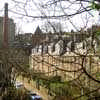
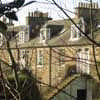
Colonies houses – images © Adrian Welch
Stockbridge Colonies
The form and layout of Rosebank Cottages provided a prototype for a number of Colony developments by the Edinburgh Co-operative Building Company. The Company was set up in 1861. Glenogle Park was their first site and work started in 1861. By 1867 the five west most terraces had been completed and the bulk of the remainder were built within the next five years, although some sites were not developed until 1911.
By 1875 the company had built over a thousand houses on this and four other sites in the city in one of the most remarkable co-operative housing ventures in Edinburgh’s history.
Stockbridge Colonies photographs
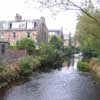
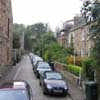
Colonies houses – images © Adrian Welch
The Stockbridge Colonies are the best monument to the movement and one which is recognised in histories of working-class housing in Britain. As well as having an interesting social history, the terraces are of architectural interest. The cottage style of the two storey terraces with high doors reached by outside stairs is quite common in the larger burghs, however, the overall scale of the layout and the detailed control of the design of the Stockbridge Colonies cannot be matched anywhere else in Scotland.
The original 1861 design was probably by the architect James Sutherland, a director of the company.
Dalry Colonies
The Dalry Colonies were erected by the Edinburgh Co-operative Building Company between 1868 and 1870 by James Colvillle. They were primarily built to house Caledonian Railway workers. Dalry Colonies are named after Scottish peers and famous reformers.
Edinburgh Colonies Summary
In summary these Edinburgh Colony properties are simple, popular and successful urban houses. The external stair gives a different feel than the traditional Scottish tenement stairs, which are frequently gloomy and unwelcoming spaces (especially in poorer areas). The Colonies streets have an asymmetric structure – stairs on one side, street levels paths at the other, that gives a humble feel – more Fife fishing village than Georgian New Town.
One problem with the Edinburgh Colonies is the relationship with the car, the street: most Colonies have a road barely wide enough to accommodate a car and deliveries and bin lorries can struggle. The Pilrig Colonies are successful in this respect as cars are excluded.
The densities are low compared to tenement blocks around the Colony houses but not suburban. The Edinburgh Colonies will always be popular as family properties due to the gardens, private access and the high quality traditional materials – stone and slate.
Scottish Capital Building Designs
Contemporary Scottish Capital Property Designs – recent architectural selection below:
Projects / buildings close to the Canonmills Colonies
Tanfield
Dundas House
Projects / buildings close to the Stockbridge Colonies
Stockbridge Buildings
Buildings / photos for the Edinburgh Colonies Architecture pages welcome
